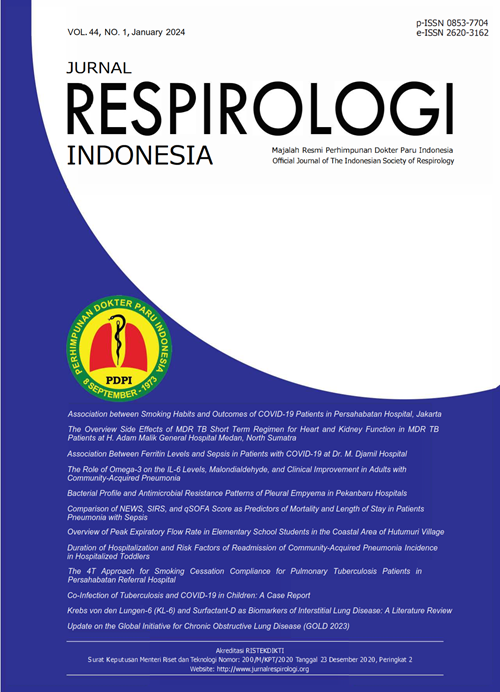Comparison of NEWS, SIRS, and qSOFA Score as Predictors of Mortality and Length of Stay in Patients Pneumonia with Sepsis
DOI:
https://doi.org/10.36497/jri.v44i1.505Keywords:
length of stay, mortality, NEWS, pneumonia, qSOFA, sepsis, SIRS, SOFAAbstract
Background: Pneumonia is a major health problem in all age groups and often related with sepsis. In 2021, Surviving Sepsis Campaign Guidelines mentioned several clinical scoring systems to identify patients with potentials of developing sepsis, such as systemic inflammatory response syndrome (SIRS), national early warning score (NEWS), quick sequential organ failure assessment (qSOFA) and sequential organ failure assessment (SOFA). The guideline stated that there is no gold standard for diagnosing sepsis, contradicting The Sepsis-3 Guideline in 2016 that mentioned SOFA score as a gold standard for diagnosing sepsis.
Methods: Subjects were all patients with pneumonia and sepsis who were treated in Dr.Moewardi Hospital within 1 January to 31 December 2022. Data from subjects’ medical records were collected to assess their NEWS, SIRS, qSOFA, and SOFA score on the day of admission. Since evaluation of SOFA score needs a number of components requiring laboratory results and takes longer time so they made a simpler tool called qSOFA to avoid delayed treatment of the patients.
Results: NEWS is more consistent with SOFA compared to SIRS and qSOFA (Kappa value = 0.726 vs 0.320 vs 0.22; respectively). NEWS, SIRS, and qSOFA were all significantly correlated with mortality (P<0.001) with NEWS having the strongest correlation (r=0.482 vs 0.216 vs 0.175; respectively). Only NEWS showed significant correlation with the length of stay (r=0.129; P<0.001).
Conclusion: NEWS was the most consistent score to SOFA compared to SIRS and qSOFA. NEWS was also the best predictor for mortality and was the only score correlated with length of hospital stay.
Downloads
References
Martin-Loeches I, Torres A. New guidelines for severe community-acquired pneumonia. Curr Opin Pulm Med. 2021;27(3):210–5.
Quinton LJ, Walkey AJ, Mizgerd JP. Integrative physiology of pneumonia. Physiol Rev. 2018;98(3):1417–64.
Evans L, Rhodes A, Alhazzani W, Antonelli M, Coopersmith CM, French C, et al. Surviving sepsis campaign: International guidelines for management of sepsis and septic shock 2021. Crit Care Med. 2021;49(11):E1063–143.
Jarczak D, Kluge S, Nierhaus A. Sepsis-pathophysiology and therapeutic concepts. Front Med (Lausanne). 2021;8:628302.
Cecconi M, Evans L, Levy M, Rhodes A. Sepsis and septic shock. Lancet. 2018;392(10141):75–87.
Gül F, Arslantaş MK, Cinel İ, Kumar A. Changing definitions of sepsis. Turk J Anaesthesiol Reanim. 2017;45(3):129–38.
Stearns-Kurosawa DJ, Osuchowski MF, Valentine C, Kurosawa S, Remick DG. The pathogenesis of sepsis. Annu Rev Pathol. 2011;6:19–48.
Taniguchi LU, Pires EMC, Vieira JM, De Azevedo LCP. Systemic inflammatory response syndrome criteria and the prediction of hospital mortality in critically ill patients: A retrospective cohort study. Rev Bras Ter Intensiva. 2017;29(3):317–24.
Willis BH, Coomar D, Baragilly M. Clinical scores in primary care. Br J Gen Pract. 2020;70(695):279.
Tian H, Zhou J, Weng L, Hu X, Peng J, Wang C, et al. Accuracy of qSOFA for the diagnosis of sepsis-3: A secondary analysis of a population-based cohort study. J Thorac Dis. 2019;11(5):2034–42.
Ramdeen S, Ferrell B, Bonk C, Schubel L, Littlejohn R, Capan M, et al. The available criteria for different sepsis scoring systems in the emergency department-A retrospective assessment. Open Access Emerg Med. 2021;13:91–6.
Srzić I, Adam VN, Pejak DT. Sepsis definition: What’s new in the treatment guidelines. Acta Clin Croat. 2022;61(Suppl 1):67–72.
Nasir N, Jamil B, Siddiqui S, Talat N, Khan FA, Hussain R. Mortality in sepsis and its relationship with gender. Pak J Med Sci. 2015;31(5):1201–6.
Martin-Loeches I, Guia MC, Vallecoccia MS, Suarez D, Ibarz M, Irazabal M, et al. Risk factors for mortality in elderly and very elderly critically ill patients with sepsis: A prospective, observational, multicenter cohort study. Ann Intensive Care. 2019;9(1):26.
Wardi G, Tainter CR, Ramnath VR, Brennan JJ, Tolia V, Castillo EM, et al. Age-related incidence and outcomes of sepsis in California, 2008–2015. J Crit Care. 2021;62:212–7.
Sinapidis D, Kosmas V, Vittoros V, Koutelidakis IM, Pantazi A, Stefos A, et al. Progression into sepsis: An individualized process varying by the interaction of comorbidities with the underlying infection. BMC Infect Dis. 2018;18:242.
Guimarães C, Lares Santos C, Costa F, Barata F. [Pneumonia associated with health care versus community acquired pneumonia: Different entities, distinct approaches]. Rev Port Pneumol. 2011;17(4):168–71.
Kim BG, Kang M, Lim J, Lee J, Kang D, Kim M, et al. Comprehensive risk assessment for hospital-acquired pneumonia: Sociodemographic, clinical, and hospital environmental factors associated with the incidence of hospital-acquired pneumonia. BMC Pulm Med. 2022;22(1):21.
Zhou HJ, Lan TF, Guo S Bin. Outcome prediction value of National Early Warning Score in septic patients with community-acquired pneumonia in emergency department: A single-center retrospective cohort study. World J Emerg Med. 2020;11(4):206–15.
Thodphetch M, Chenthanakij B, Wittayachamnankul B, Sruamsiri K, Tangsuwanaruk T. A comparison of scoring systems for predicting mortality and sepsis in the emergency department patients with a suspected infection. Clin Exp Emerg Med. 2021;8(4):289–95.
Abbott TEF, Torrance HDT, Cron N, Vaid N, Emmanuel J. A single-centre cohort study of National Early Warning Score (NEWS) and near patient testing in acute medical admissions. Eur J Intern Med. 2016;35:78–82.
Khwannimit B, Bhurayanontachai R, Vattanavanit V. Comparison of the accuracy of three early warning scores with SOFA score for predicting mortality in adult sepsis and septic shock patients admitted to intensive care unit. Heart and Lung. 2019;48(3):240–4.
Downloads
Published
Issue
Section
License
- The authors own the copyright of published articles. Nevertheless, Jurnal Respirologi Indonesia has the first-to-publish license for the publication material.
- Jurnal Respirologi Indonesia has the right to archive, change the format and republish published articles by presenting the authors’ names.
- Articles are published electronically for open access and online for educational, research, and archiving purposes. Jurnal Respirologi Indonesia is not responsible for any copyright issues that might emerge from using any article except for the previous three purposes.
















